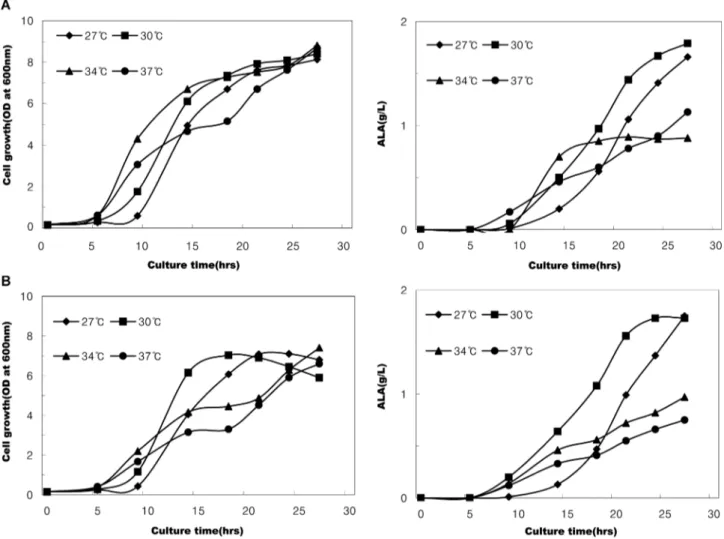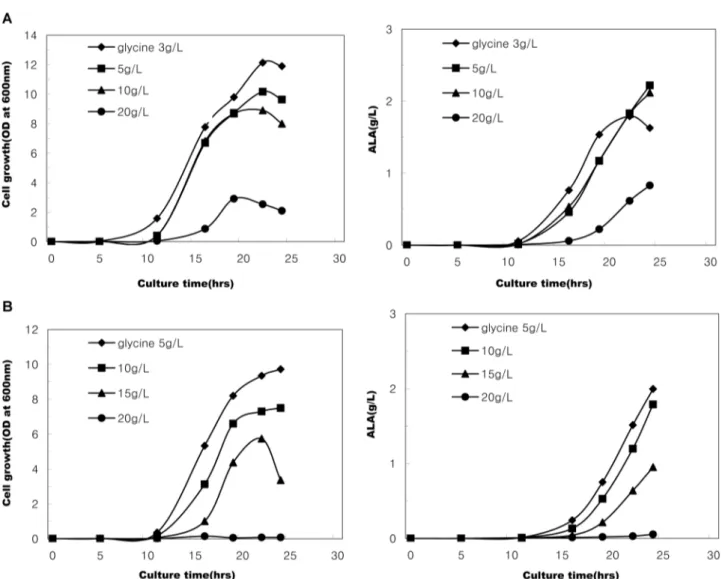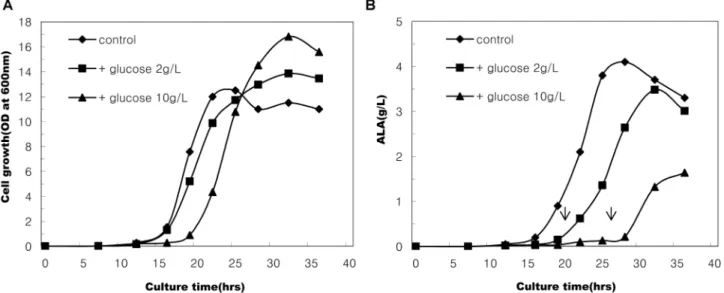Rhodobacter capsulatus hemA 유전자 발현 대장균에 의한 5-Aminolevulinic Acid 생산의 최적화
양동수1·박문원1·임수진·김민정·신유리·박찬수2·현 영2·강대경*
단국대학교 동물자원학과, 1(주)압선비씨엘, 2(주)이지바이오시스템
Optimizing the Production of 5-Aminolevulinic Acid by Recombinant Escherichia coli Containing the Rhodobacter capsulatus hemA Gene. Yang, Dong-Soo1, Moon-Won Park1, Soo Jin Lim, Min Jeong Kim, Yuri Shin, Chan Soo Park2, Young Hyun2, and Dae-Kyung Kang*. Department of Animal Resources Sci- ence, Dankook University, Cheonan 330-714, Korea, 1Abson BioChemica Lab, Ansan 425-220, Korea, 2EASY BIO System, Inc, Cheonan 330-811, Korea - Recombinant Escherichia coli BLR(DE3) harboring the hemA gene from Rhodobacter capsulatus under the control of a constitutive promoter, which we constructed previ- ously, was used for the extracellular production of 5-aminolevulinic acid (ALA). The effects of several factors on ALA production were investigated in flask culture. ALA production by the recombinant E. coli was more efficient at 30oC than 37oC. The glycine concentration had an important effect on cell growth. Glycine and succinic acid concentration of 5-10 and 10-20 g/L, respectively, resulted in high ALA production. In addition, the partial replacement of succinic acid by sodium glutamate increased the ALA production. The ALA pro- duction was inhibited by the presence of glucose in the medium. Using the optimal conditions, an ALA con- centration of 8.2 g/L was achieved in jar fermentation without an added inducer or ALA dehydratase inhibitor;
this is the highest reported concentration.
Key words: 5-Aminolevulinic acid, recombinant Escherichia coli, glycine, succinic acid, glutamate, glucose
서 론
5-aminolevulinic acid(ALA)는 heme, chlorophyll, porphyrin 등의 pyrrole 화합물을 합성하는 전구물질로서 대부분의 생 물체에서 합성된다[2, 10]. 생체내 ALA 생합성에는 두 가지 경로가 알려져 있는데 동물, 효모, 진균 및 일부 세균에서는 succinyl CoA와 glycine을 기질로 하여 ALA synthase (HemA)에 의해 합성된다(C4 pathway)[1, 16]. 한편, 식물 및 cyanobacteria 등의 일부 세균에서는 glutamic acid를 전구물 질로 사용하여 ALA가 합성되는 C5 pathway가 알려져 있다
[2]. ALA의 용도는 다양하게 알려져 있는데, heme 구조를
가진 각종 효소나 비타민 B12의 전구물질로 사용될 뿐만 아 니라[4], 암 진단 및 치료제[3], 생물농약[28], 동물 및 어류 의 생산성 향상[5, 21, 27] 등과 같이 다양한 분야에서 연구 되고 있다.
이와 같이 다양한 용도를 가진 ALA를 산업적으로 이용 하기 위해서는 경제적으로 생산하는 기술이 필요하다. ALA 의 화학적 합성은 합성 단계가 복잡할 뿐만 아니라 생산수 율이 낮은 것으로 알려져 있으며[23], 광합성 세균 또는 조
류의 야생주 또는 변이주를 이용한 생물학적 생산방법은 배양 시에 빛을 조사해야 한다든지, 장시간 배양에 의한 생 산비용 증가 등의 단점이 있다[29]. 따라서, 유전자 재조합 기술을 이용하여 ALA 대량생산 균주를 개발함으로써 ALA 의 생산수율을 향상시키는 연구가 최근 들어 활발히 이루 어지고 있다. 즉, 광합성 세균인 Rhodobacter sp.[32], Rhodopseudomonas sp.[7] 또는 Bradyrhizobium japonicum [6] 유래의 ALA 생합성 유전자(hemA)를 대장균에서 발현시 키거나, 대장균의 C4대사경로 조절을 통하여[30] ALA의 생산성을 향상시키는 경우가 대부분이다. 하지만, 이러한 연 구의 대부분은 inducible promotor를 이용하여 ALA생합성 유전자를 발현시키는 방법으로서 IPTG와 같은 고가의 유 도물질을 사용해야 하는 단점이 있으며, 또한 ALA 생산성 을 향상시키기 위해 ALA분해억제물질을 배양 도중에 첨가 해야 하는 문제점이 있다. Kang 등[15]은 Rhodobacter capsulatus 유래의 hemA 유전자를 항시발현벡터에 클로닝한 후 대장균에서 발현시킴으로써, 고가의 유도물질이나 ALA 분해 억제물질을 사용하지 않고도 ALA를 생산할 수 있음 을 기 보고한 바 있다. 본 연구에서는, 기 구축된 발현시스 템을 사용하여 재조합대장균의 배양온도, 기질의 종류 및 적 정 농도 등의 배양조건들을 보다 자세히 조사하고 이를 jar
fermenter 수준의 발효에 적용함으로써, 기 보고들에 비해 높
은 농도의 ALA를 배양액으로부터 얻을 수 있었다.
*Corresponding author
Tel: 82-41-550-3655, Fax: 82-41-564-3655 E-mail: dkkang@dankook.ac.kr
toebii 유래의 D-amino acid aminotransferase (D-AAT) 유 전자의 promotor가 존재하며, 발현유도물질을 첨가하지 않 아도 세포생장 의존적으로 HemA 효소의 발현이 가능하였 다[25]. 재조합 플라스미드 pHEMA를 Escherichia coli BLR(DE3) (Takara, Japan)에 도입되어 ALA 생산실험에 사 용하였다. 전 배양용 배지로 Luria-Bertani 액체배지(Difco, USA)를 사용하였다.
발효 실험
배양시험에 사용한 기본 배지로 SGYP 배지(succinic acid 10 g/L, glycine 5 g/L, yeast extract 10 g/L, peptone 5 g/L, K2HPO4 10 g/L, pH 6.3)를 사용하였으며, 재조합 플라스미 드의 안정성을 유지하기 위해 ampicillin(Sigma, USA, 50 µg/mL)을 첨가하였다. 플라스크 배양실험의 경우, SGYP 배 지 50 mL에 전배양액 1%를 접종하여 진탕배양기에서 교반 배양(180 rpm) 하였다. Jar fermentor배양실험의 경우, 2.5 L glass-jar(KoBiotech Co., Korea)에 1.2 L의 SGYP 배지를 투입하고 멸균한 후에 전배양액 1%(v/v)를 접종하였다. 반 응기의 운전조건은 30oC, ~1,200 rpm, 통기량 0.5 vvm으로 하였으며, 5 N 황산용액을 사용하여 배양액의 pH를 6.3으로 유지하였다.
분석방법
배양액 중의 ALA는 Ehrlich's reagent를 사용하여 정량하 였다[22]. 배양액의 원심분리 상등액 또는 이의 희석액 10 µL를 1 M sodium acetate 완충용액(pH 4.6) 1.0 mL와 혼합 하여 acetylacetone 50 µL을 첨가하고, 10분간 끓는 물에 중 탕한 후 상온으로 냉각하였다. 상기 용액 1 mL에 신선한 Ehrich 시약(γ-dimethylaminobenzaldehyde 1.0 g, glacial acetic acid 42.0 mL, 70% perchloric acid 8.0 mL) 1 mL 를 혼합하고, 5분 후에 555 nm에서 흡광도를 측정하였다.
ALA(Sigma, USA)의 표준용액으로부터 얻은 정량곡선을 이
용하여 시료 중의 ALA 함량을 구하였다. 상기 시험법에서 10µL의 시료를 취한 경우, OD555= 1.0은 대략 ALA 1.0 g/
L에 해당하였다. Succinic acid의 정량을 위해서는 Aminex HPX-87H organic acid column(Bio-Rad, USA)을 사용하였 으며, 0.02 N sulfuric acid, 0.5 mL/min 조건에서 HPLC (Gilson, France) 분석을 수행하였다. 배양액 중의 glucose 농
재조합 대장균의 최적 생장온도는 glycine 5 g/L 첨가구 및
glycine 10 g/L 첨가구 공히 일반적으로 알려져 있는 대장
균의 최적 생장온도인 37oC보다 낮았다(Fig. 1). 한편, 5- aminolevulinic acid(ALA) 생성속도도 glycine 5 g/L 첨가구 및 glycine 10 g/L 첨가구 공히 37oC에서 가장 낮은 경향을 나타내었으며, 30oC 에서 최대 생성속도를 나타내었다(Fig.
1). 대체로 27-30oC 범위에서 균의 생육과 ALA생성이 잘 연관되어 안정적으로 ALA가 생성되는 것으로 나타났으므 로, 배양 적정온도를 30oC로 설정하였다. 재조합 대장균의 적정 배양온도가 낮아진 것은 배지에 함유되어 있는 과량의 유기산과 glycine이 영향을 미쳤을 것으로 추정되며, 또한 상 대적으로 낮은 배양온도가 배양 중에 생성된 ALA의 불안 정성을 줄이는 데에도 도움이 되었기 때문으로 추정된다.
Chung 등[8]은 재조합 대장균의 배양온도가 30oC일 경우가 37oC에서 배양할 때보다 균체 생장은 빨랐으나 ALA 생산 성은 상대적으로 낮았다고 보고한 바 있는데, 이는 재조합 균주의 종류나 배양 조건 등에 따라 적정 배양온도가 달라 질 수 있다는 점을 시사하였다.
Succinic acid 농도별 glycine의 적정농도
Succinic acid 및 glycine은 ALA 생산을 위한 전구물질로 서 중요하며, succinic acid 는 세포 생장을 위한 탄소원으로 도 이용된다. 따라서 고농도의 기질을 배지에 첨가하는 것 이 유리할 수 있으나 기질에 의한 생장 억제작용 때문에[11,
26], 재조합 대장균의 생장 억제를 최소화하면서 최대의 ALA
생산을 유도할 수 있는 적정 기질농도를 설정하는 것이 중 요하다. 따라서 이전의 연구결과[15]를 참조하여 succinic acid 농도 10 g/L 및 20 g/L인 경우 각각 glycine의 적정 첨 가농도를 조사하였다.
먼저, succinic acid 10 g/L첨가구에 있어서 glycine 3-20 g/L를 배지에 첨가하여 배양한 결과, Fig. 2(A)에서 보는 바 와 같이 glycine 농도가 높아질수록 세포생장은 억제되었다.
Glycine 3 g/L 첨가구에서는 세포생장 속도 및 초기ALA생
성 속도가 가장 빨랐으나, 배양 20시간 이후에는 기질인
glycine의 부족으로 인하여 ALA생합성이 억제되었다.
Glycine 농도 10 g/L 수준에서는 세포생장이 약간 저해되었
으나 ALA 생성은 오히려 촉진되어 배양 24시간 후에 2.2- 2.3 g/L 수준에 이르렀다. 하지만 glycine 20 g/L 첨가구에서
는 세포생장이 심각하게 저해되었을 뿐만 아니라, ALA 생 성량도 상대적으로 미약하였다(Fig. 2A). 한편, succinic acid 20 g/L 첨가구의 경우에도 succinic acid 10 g/L 첨가구와 마 찬가지로 glycine 농도가 높아질수록 세포생장이 심각하게 저해되었는데, ALA 생산성 측면에서 고려할 때 glycine 5- 10 g/L 농도 범위를 첨가하는 것이 가장 유리하였다(Fig.
2B).
Qin 등[26]은 Agrobacterium radiobacter hemA 유전자를 도입한 재조합 대장균에 있어서 succinic acid 13 g/L까지는 세포생장을 저해하지 않고도 ALA 생산을 향상시킬 수 있다 고 하였으나, Fu 등[11]은 Rhodobacter sphaeroides hemA 유전자를 도입한 대장균 배양실험에 있어서 10 g/L 이상의 succinic acid는 ALA 생산에 불리하다고 하였다. 또한, 일정 농도의 glycine(6-12 mM)은 대장균 생장 촉진효과가 있으나 [14], glycine 농도가 너무 높은 경우에는 오히려 세포벽 펩 티도글리칸의 합성과정을 저해하는 것으로 알려져 있다[9,
13]. 본 실험에서도 glycine 첨가농도가 높아질수록 세포 생
장이 억제되는 경향을 나타내었는데, ALA 생산성 측면에서 는 glycine 5-10 g/L 수준 첨가가 유리하였으며, succinic acid도 20 g/L 수준까지는 세포생장의 심각한 저해 없이 ALA 생성을 촉진하는 효과를 나타내었다.
Glutamate 첨가에 의한 영향
Glutamate는 TCA cycle을 통하여, α-ketoglutarate ↔
succinate로 바로 전환되어, ALA생합성의 전구체로 작용할
수 있을 뿐 아니라, proline, glutamine, agrinine 등의 아미 노산으로 전환되는 중요한 대사 중간체이다. 따라서, succinic acid 20 g/L의 일부 또는 전부를 glutamate로 대체하였을 경 우에 ALA 생산에 미치는 영향을 조사하였다. Fig. 3에서 보 는 바와 같이, succinic acid 전부를 glutamate로 대체했을 경우에는 세포생장 및 ALA 생산량이 가장 낮았다. 한편, succinic acid와 glutamate를 1:1의 비율로 혼용했을 경우에 는 succinic acid 20 g/L 단독 첨가구보다 세포 생장 및 ALA 생산성 측면에서 유리하였다.
Fig. 1 Effects of temperature on the growth of recombinant E. coli and ALA production in SGYP medium (initial pH 6.3) contain- ing glycine 5 g/L (A series) or 10 g/L (B series).
Fig. 2. Effects of glycine concentration on the growth of recombinant E. coli and ALA production in SGYP medium (initial pH 6.3) containing succinic acid 10 g/L (A series) or 20 g/L (B series).
Fig. 3. Effect of the substitution of glutamate for succinic acid on the growth of recombinant E. coli (A) and ALA production (B) in SGYP medium (initial pH 6.3). Suc, succinate; glut, Na-glutamate.
Glucose 첨가에 의한 영향
ALA생합성 효율을 높이기 위해 glucose와 같이 미생물이 쉽게 이용할 수 있는 탄소원을 추가로 공급함으로써 세포생 장을 촉진시킴으로써 대사산물의 생산을 촉진시키는 방법을 고려해 볼 수 있다. 또한 glucose는 ALA 가수분해효소 저 해제로 작용하기 때문에, 생성된 ALA가 분해되는 것을 억 제함으로써 ALA 생산량을 증가시킬 수 있는 것으로 보고 된 바 있다[17, 26, 30]. 본 실험에서도 glucose를 농도별로
(0-10 g/L) 배지에 첨가하여 배양하면서 ALA 생성량을 조사
하였다. Fig. 4에서 보는 바와 같이, glucose 첨가 농도가 증 가할수록 최종 균체량도 증가하였으나, glucose가 모두 소비 된 후에 ALA 생합성이 시작되었으며 ALA 생성량도 glucose 무첨가구에 비해 낮게 나타났다. 이와 같은 결과는, 에너지
원으로서 glucose의 잇점보다는 glucose가 succinic acid의 세포내 흡수를 억제하거나[20], TCA cycle 내 효소의 활성 을 억제함으로써[12, 24, 31] ALA 생합성에 역효과를 나타 내는 것으로 추측된다. 결과적으로, 본 실험조건에서의 ALA 생산에 glucose를 첨가하는 것은 바람직하지 않을 것으로 판 단되었다.
Jar fermentor 배양실험
이상과 같은 flask 배양시험들을 통하여 얻은 배양 조건 및 배지 조성을 토대로 하여, 2.5 L jar fermentor에서 ALA 생산시험을 수행하였다(Fig. 5). 배양 중의 pH 상승을 막기 위해 5 N 황산용액을 첨가하여 pH 6.3으로 유지하였다. 세 포 생장과 동반하여 succinic acid 량이 지속적으로 감소하
Fig. 4. Effects of glucose supplement on the growth of recombinant E. coli and ALA production in SGYP medium (initial pH 6.3) added Na-glutamate 10 g/L. A. cell growth; B. ALA production. The arrows indicate the time at which glucose was depleted.
Fig. 5. Cell growth and ALA production profiles in fed-batch fermentation of the recombinant E. coli containing hemA gene on pH- stat control. A. cell growth; B. ALA production. SGYP medium added Na-glutamate 10 g/L was used for jar fermentation. The arrow indi- cates the time of feeding succinic acid 5 g/L and glycine 5 g/L, respectively.
막을 통과하여 세포 밖으로 나오는데 시간이 소요되기 때문 으로 추정된다.
본 연구에서 유전자재조합 대장균으로부터 ALA를 고농 도로 생산할 수 있는 공정을 개발하기 위해 배양온도, 기질 의 농도, 탄소원 및 glutamate의 영향, 유가배양의 효과 등 을 조사하였다. Lee 등[17]은 Bradyrhizobium japonicum hemA 유전자를 발현시킨 대장균으로부터 3.9 g/L 수준의 ALA 를 얻었으며, Choi 등[7]은 Rhodopseudomonas palustris
hemA 유전자를 발현시킨 대장균의 배양 최적화를 통해 5.15
g/L 수준의 ALA를 얻었다고 보고하였다. 또한, 최근 들어 재조합 대장균의 유가식 배양 최적화를 통하여 6.6 g/L 수준 의 고농도 ALA를 얻을 수 있었다고 보고된 바 있다[11].
하지만, 지금까지 보고된ALA 생산성 증대 연구는 ALA dehydratase 저해제인 levulinic acid(LA)나 d-glucose를 배 양 중에 첨가하는 경우[6, 18, 19, 26], 또는 ALA 생합성효 소의 발현을 위해 고가의 inducer인 IPTG를 첨가함으로써 이루어졌다[6, 11, 18, 30]. 본 연구에서는 항시발현벡터를 사용하였기 때문에 고가의 유도제가 필요하지 않으며, 또한 LA나 d-glucose와 같은ALA dehydratase inhibitor를 첨가하 지 않고도 지금까지 보고된 결과보다 더 높은 수준인 8.2 g/
L 이상의 ALA를 얻을 수 있었다.
요 약
Rhodobacter capsulatus 유래의 hemA 유전자를 항시발현 벡터(pHCEIIB vector)에 클로닝한 후 과발현시킨 Escherichia coli BLR(DE3) 균주를 사용하여, 5-aminolevulinic acid
(ALA) 생산을 위한 적정 배양조건을 조사하였다. ALA 생
산을 위한 배양온도는 37oC보다는 30oC에서 더 나은 결과 를 나타내었다. Glycine 농도가 세포생장에 미치는 영향이 컸으며, 세포생장을 저해하지 않고ALA를 고농도로 생산하 기 위한 적정 glycine 농도는 5-10 g/L 수준이었다. Succinic acid의 적정 첨가수준은 10-20 g/L이었으며, succinic acid의 일부를 glutamate로 대체할 경우에 ALA의 생산량을 향상시 키는 효과가 있었다. 한편, 배지 중의 glucose 첨가는 ALA 생산성을 저하시키는 결과를 초래하였다. 이상과 같은 배양 조건 최적화를 통한 jar-fermentor 발효실험을 통하여, 고가 의 유도제(IPTG)나 ALA dehydratase inhibitor를 첨가하지
1. Avissar, Y. J. and S. I. Beale. 1989. Identification of the enzymatic basis for ä-aminolevulinic acid auxotrophy in a hemA mutant of Escherichia coli. J. Bacteriol. 171: 2919- 2924.
2. Beale, S. J. and P. A. Castelfranco. 1974. The Biosynthesis of δ-aminolevulinic acid in higher plants. II. Formation of
14C-δ-aminolevulinic acid from labeled precursors in greening plant tissue. Plant Physiol. 53: 297-303.
3. Berg, K., P. K. Selbo, A. Weyergang, A. Dietze, L. Prasmickaite, A. Bonsted, BØ Engesaeter, E. Angell-Petersen, T. Warloe, N. Frandsen, and A. Høgset. 2005. Porphyrin-related photo- sensitizers for cancer imaging and therapeutic applications.
J. Microsc. 218: 133-147.
4. Bykhovsky, V. Y., A. L. Demain, and N. I. Zaitseva. 1997.
The crucial contribution of starved resting cells to the elucidation of the pathway of vitamin B12 biosynthesis.
Critical Rev. Biotechnol. 17(1): 21-37.
5. Chen, Y. J., J. H. Cho, J. S. Yoo, Y. Wang, Y. Huang, I. H.
Kim. 2008. Evaluation of ä-aminolevulinic acid on serum iron status, blood characteristics, egg performance and quality in laying hens. Asian-Aust. J. Anim. Sci. 21: 1355- 1360.
6. Choi, C., B.-S. Hong, H.-C. Sung, H.-S. Lee, and J. H. Kim.
1999. Optimization of extracellular 5-aminolevulinic acid production from Escherichia coli transformed with ALA synthase gene of Bradyrhizobium japonicum. Biotechnol.
Lett. 21: 551-554.
7. Choi, H.-P., Y.-M. Lee, C.-W. Yun, and H.-C. Sung. 2008.
Extracellular 5-aminolevulinic acid production by Escherichia coli containing the Rhodopseudomonas palustris KUGB306 hemA gene. J. Microbiol. Biotechnol. 18(6): 1136-1140.
8. Chung S.-Y., K.-K. Seo, K.A. Han, S. H. Cho, K. H. Bak, and J. I. Rhee. 2004. Production and process monitoring of 5-aminolevulinic acid [ALA] by recombinant E. coli. I.
Characteristics of ALA production. Kor. J. Biotech. Bioeng.
19(1): 17-26.
9. Dempsey, W. B. 1973. Lysis of Escherichia coli by glycine is potentiated by pyridoxine starvation. J. Bacteriol. 116(1):
373-377.
10. Ferreira, G. and J. Gong. 1995. 5-Aminolevulinate synthase and the first step of heme biosynthesis. J. Bioenerg.
Biomembr. 27: 151-159.
11. Fu, W., J. Lin, and P. Cen. 2008. Enhancement of 5- aminolevulinate production with recombinant Escherichia
coli using batch and fed-batch culture system. Bioresource Technol. 99: 4864-4870.
12. Halpern, Y. S., A. Ecen-shoshan, and M. Artman. 1964.
Effect of glucose on the utilization of succinate and the activity of tricarboxylic acid-cycle enzymes in Escherichia coli. Biochim Biophys Acta. 93: 228-236.
13. Hammets, W., K. H. Schleifer, and O. Kandler. 1973. Mode of action of glycine on the biosynthesis of peptidoglycan. J.
Bacteriol. 116(2): 1029-1053.
14. Han, L., M. Doverskog, S. O. Enfors, and L. Häggström.
2002. Effect of glycine on the cell yield and growth rate of Escherichia coli: evidence for cell-density-dependent glycine degradation as determined by (13)C NMR spectroscopy. J. Biotechnol. 92(3): 237-249.
15. Kang, D.-K., S. S. Kim, W.-J. Chi, S.-K. Hong, H. K. Kim and H. U. Kim. 2004. Cloning and expression of the Rhodobacter capsulatus hemA gene in E. coli for the pro- duction of 5-aminolevulinic acid. J. Microbiol. Biotechnol.
14(6): 1327-1332.
16. Kikuchi, G., A. Kumor, P. Talmage, and D. Shemin. 1958.
The enzymatic synthesis of ä-aminolevulinic acid. J. Biol.
Chem. 233: 1214-1219.
17. Lee, D.-H., W.-J. Jun, K.-M. Kim, D.-H. Shin, H.-Y. Cho, and B.-S. Hong. 2003. Inhibition of 5-aminolevulinic acid dehydratase in recombinant Escherichia coli using D- glucose. Enz. Microbial Technol. 32: 27-34.
18. Lee, D.-H., W.-J. Jum, J.-W. Yoon, H.-Y. Cho, and B.-S.
Hong. 2004. Process strategies to enhance the production of 5-aminolevulinic acid with recombinant E. coli. J. Microbiol.
Biothchnol. 14(6): 1310-1317.
19. Lee, D.-H., W.-J. Jun, D.-H. Shin, H.-Y. Cho, and B.-S.
Hong. 2005. Effect of culture conditions on production of 5- aminolevulinic acid by recombinant Escherichia coli. Biosci.
Biotechnol. Biochem. 69(3): 470-476.
20. Lo, T. C. Y., K. Rayman, and H. D. Sanwal. 1972. Transport of succinate in Escherichia coli. I. Biochemical and genetic studies of transport in whole cells. J. Biol. Chem. 247(19):
6323-6331.
21. Mateo, R. D., J. L. Morrow, J. W. Dailey, F. Ji, S. W. Kim.
2006. Use of delta-aminolevulinic acid in swine diet: effect on growth performance, behavioral characteristics and hematological/immune status in nursery pigs. Asian-Aust. J.
Anim. Sci. 1: 97-101.
22. Mauzerall, D and S. Granick, 1956. The occurance and
determination of δ-aminolevulinic acid and porphobilinogen in urine. J. Biol. Chem. 219(11): 435-446.
23. Miyachi, N., T. Tanaka, S. Nishikawa, H. Takeya, and Y.
Hotta. 1998. Preparation and chemical properties of 5- aminolevulinic acid and its derivatives. Porphyrins 7: 342- 347.
24. Nam, T.-W., Y.-H. Park, H.-J. Jeong, S. Ryu, and Y.-J. Seok.
2005. Glucose repression of the Escherichia coli sdhCDAB operon, revisited: regulation by the CRP· cAMP complex.
Nucleic Acids Res. 33(21): 6712-6722.
25. Poo, H., J. J. Song, S.-P. Hong, Y.-H. Choi, S. W. Yun, J.-H.
Kim, S. C. Lee, S.-G. Lee, and M. H. Sung. 2002. Novel high-level constitutive expression system, pHCE vector, for a convenient and cost-effective soluble production of human tumor necrosis factor-aaa. Biotechnol. Lett. 24: 1185-1189.
26. Qin, G., J. Lin, X. Liu, and P. Cen. 2006. Effect of medium composition on production of 5-aminolevulinic acid by recombinant Escherichia coli. J. Biosci. Bioeng. 102(4):
316-322.
27. Rebeiz, C. A., A. Montaxer-Zouhool, H. Hopen, and S, M.
Wu. 1984. Photodynamic herbicides. I. Concepts and pheno- menology. Enzyme Microb. Technol. 6: 390-401.
28. Sasikala, Ch., Ch. V. Ramana, and P. R. Rao. 1994. 5- Aminolevulinic acid: a potential herbicide/insecticide from microorganisms. Biotechnol. Prog. 10: 451-459.
29. Sasaki, K., M. Watnabe, T. Tanake, and T. Tanaka. 2002.
Biosynthesis, biotechnological production and applications of 5-aminolevulinic acid. Appl. Microbiol. Biotechnol. 58:
23-29.
30. Shin, J.-A., Y. D. Kwon, O.-H. Kwon, H. S. Lee, and P.
Kim. 2007. 5-Aminolevulinic acid biosynthesis in Escherichia coli coexpressing NADP-dependent malic enzyme and 5- aminolevulinate synthase. J. Microbiol. Biotechnol. 17(9):
1579-1584.
31. Takahashi, Y. 1975. Effect of glucose and cyclic Adenosine 3', 5'-monophosphate on the synthesis of succinate dehydro- genase and isocitrate lyase in Escherichia coli. J. Biochem.
78(5): 1097-1100.
32. Van der Werf, M. J. and J. G. Zeikus. 1996. 5-Aminolevulin- ate production by Escherichia coli containing the Rhodo- bacter sphaeroides hemA gene. Appl. Environ. Microbiol.
62: 3560-3566.
(Received April 10, 2009/Accepted May 11, 2009)


